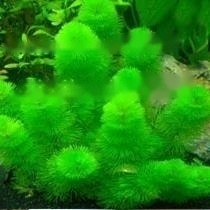
Chinese name: golden fish algae
Latin name: Ceratophyllum demersum L.
Aliases: fine grass, fish grass, Soft grasses, pine algae
Genus: Hornwort genus
Species: Hornwort
Latin name: L., 1828
1 , Morphology of Hornwort
Hornwort is a perennial submerged herb with stem veins ranging from 40 cm to 150 cm in length, very smooth and branched. The leaves are in whorls of four to twelve, one or two bifurcated branches. The lobes are filiform or filiform strips, 1.5 cm to 2 cm in length, 0.1 mm to 0.5 mm in width, cartilage at the front, white, and serrated on one side at the edge. The flower is about two millimeters in diameter, with nine to twelve bracts, bar-shaped, 1.5 to 2 millimeters long, light green, and transparent.
2. Habits of hornwort
The seeds of hornwort have a hard shell and have a long dormancy period, which can be released by low temperature in winter. Seeds germinate in the mud in early spring and grow upwards to the surface. When the seed germinates, the radicle does not elongate, so the plant has no root, and the plant is fixed by the leaf-like branches that grow into the soil. At the same time, the lateral branches at the base also develop very thin fully split leaves, which are similar to the root-like branches of white thin lines. Fix the plant and absorb nutrients. In autumn, when the light becomes shorter and the temperature drops, the top of the lateral branches stops growing, the leaves are densely clustered, the color becomes dark green, the cuticle thickens, and nutrients such as starch accumulate, becoming a special vegetative propagule, the dormant terminal bud. At this time, the plant becomes brittle, the terminal bud is easy to fall off, sinks in the mud to overwinter, and germinates into a new plant in the spring of the second year. In addition, broken plants can develop into new plants at any time during the growing season.
3. Cultivation of Hornwort
Hornwort cultivation is suitable for dense but not sparse. If farmers want to achieve high yield, if the basic seedlings are insufficient, it will be difficult to increase the output. Generally speaking, it is advisable to transplant 200 tents per mu of water for cultivating this kind of aquatic plants. During the breeding process, the fertilizer should be fat but not thin. If you choose to grow hornwort on the barren waters where you can't grow fish and shrimp. These inferior waters should be removed before planting sphagnum moss and other weeds, and then apply 25 kg of superphosphate per acre of water surface as base fertilizer, and less nitrogen fertilizer to prevent green algae from occupying the water surface. Then plant hornwort.
Guess you like it
Houttuynia cordata | Manjianghong | Gorgon fruit | calamus | bowl lotus | | Hornwort|
Duckweed| Cattail| Cigu| Cress|Snow White| copper money grass | dracaena | green apple | morning glory | mosquito repellent | basil | ingot tree | African jasmine | sage | bamboo cypress | | Emerald | Duck palm wood | Bird's nest fern |
![[Dog Training 5] The training method of pet dog dining etiquette](/static/img/12192/12192_1.jpg)




